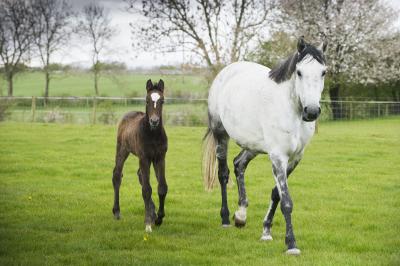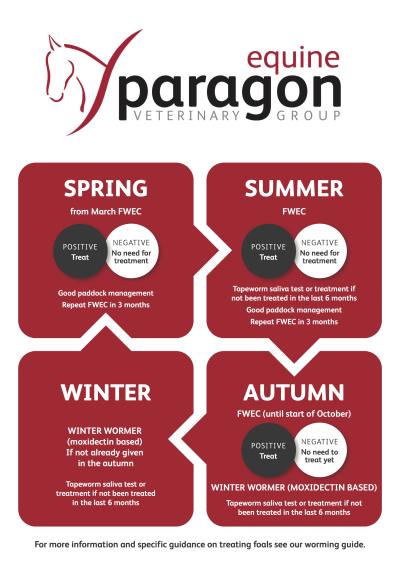
By vet Charlotte Pennington
Worms are parasites affecting horses and donkeys. There are many different types. They include large redworms (strongyles), small redworms (cyathostomins), roundworms (ascarids), pinworm, tapeworm, lungworm, threadworm and bots.
Although there are slight variations in the lifecycle depending on the type of worm, in general worm eggs are ingested from infected pastures.

Once inside the horse, usually in the gut, the eggs then develop into larvae, then into adult worms. Adults shed new eggs out in the horse’s faeces, which increases existing worm burdens on the pasture allowing new infections.
For red worms specifically the developing larvae halt their lifecycle when climate is unfavourable (usually winter) and remain encysted inside the horse’s gut. When climate is more favourable these larvae reactivate again where they can cause problems.
When present in low numbers, worms cause minimal problems. However, when present in larger numbers, they can affect the horse’s health resulting in symptoms such as poor body condition, colic and general ill health.
Over recent years strategies for worming horses have had to change to adapt to target which type of worm is of most concern and combat resistance to wormers used.
There is no one-size-fits-all strategy, but we use a combination of monitoring tests to decide if treatment is needed alongside strategic treatment at times of most risk.
The ultimate goal of this is to keep infection levels low so that horses remain healthy, but also ensure we are not incorrectly or overusing wormers which over time can make these drugs less effective at treating parasites as they can become resistant.
Here are some key points regarding worming adult horses:

Adults have a good immunity to parasites gained with age and we mainly target treatments against small redworms and tapeworm.
Worm egg counts should be performed regularly every 3 months from March to late September. If treatment is needed, vets can advise which treatment is best depending on the situation and time of year.
Ensure horses are treated at least once per year for encysted red worms and tape worms. This is usually done at the end of the grazing season over winter. A good time is after first frost sometime between November/Feb. We use Moxidectin + Praziquantel in most cases or a 5 days Fenbendazole course. This treatment is timed to treat horses when there is the highest level of larvae living in the gut wall, and also ensures any tapeworms are treated.
Individual horses may vary, some may be high shedders and need additional treatments but the above is a good start point.
Key points when worming foals:
Foals do not have immunity to parasites, this needs to be developed over time as they are exposed, so they are much higher risk. With foals it is one of the few instances we recommend regular treatments (without egg counts) routinely every 3 months until 1 year old. For example:
● First wormer 2-3 months against ascarids with Fenbendazole
● Second treatment at 4-6 months just before weaning with Fenbendazole
● If the time between the first and second wormer is > 3 months then an additional dose of Fenbendazole pre weaning is justified
● Third treatment is at 9 months against tapeworm and strongyles e.g. Ivermectin + Praziquantel
● Fourth treatment is at 12 months against strongyles e.g. Ivermectin
● Thereafter yearlings should follow an adult worming programme as per above with regular worm egg counts and minimum of an annual, well timed winter worming treatment. However, bear in mind, they are likely to be high shedders of eggs so may need more frequent treatments than older adults.
Some wormers must not be used in younger foals, so it is always best to check before administering.